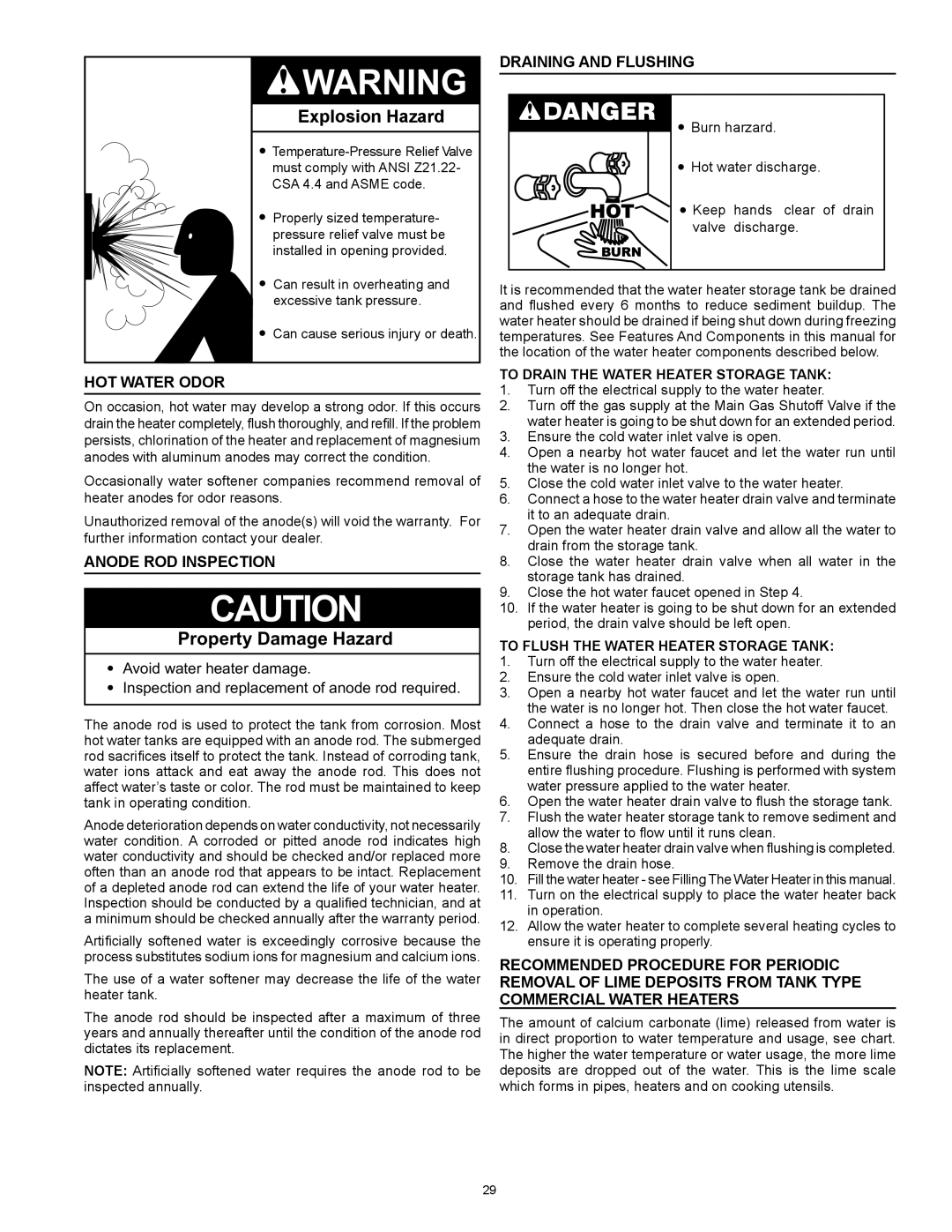
explosion hazard
![]()
Properly sized temperature- pressure relief valve must be installed in opening provided.
Can result in overheating and excessive tank pressure.
![]() Can cause serious injury or death.
Can cause serious injury or death.
Hot Water Odor
On occasion, hot water may develop a strong odor. If this occurs drain the heater completely, flush thoroughly, and refill. If the problem persists, chlorination of the heater and replacement of magnesium anodes with aluminum anodes may correct the condition.
Occasionally water softener companies recommend removal of heater anodes for odor reasons.
Unauthorized removal of the anode(s) will void the warranty. For further information contact your dealer.
Anode Rod Inspection
CAUTION
Property Damage Hazard
•Avoid water heater damage.
•Inspection and replacement of anode rod required.
The anode rod is used to protect the tank from corrosion. Most hot water tanks are equipped with an anode rod. The submerged rod sacrifices itself to protect the tank. Instead of corroding tank, water ions attack and eat away the anode rod. This does not affect water’s taste or color. The rod must be maintained to keep tank in operating condition.
Anode deterioration depends on water conductivity, not necessarily water condition. A corroded or pitted anode rod indicates high water conductivity and should be checked and/or replaced more often than an anode rod that appears to be intact. Replacement of a depleted anode rod can extend the life of your water heater. Inspection should be conducted by a qualified technician, and at a minimum should be checked annually after the warranty period.
Artificially softened water is exceedingly corrosive because the process substitutes sodium ions for magnesium and calcium ions.
The use of a water softener may decrease the life of the water heater tank.
The anode rod should be inspected after a maximum of three years and annually thereafter until the condition of the anode rod dictates its replacement.
NOTE: Artificially softened water requires the anode rod to be inspected annually.
Draining and Flushing
![]()
![]() Burn harzard.
Burn harzard.
![]() Hot water discharge.
Hot water discharge.
![]() Keep hands clear of drain valve discharge.
Keep hands clear of drain valve discharge.
It is recommended that the water heater storage tank be drained and flushed every 6 months to reduce sediment buildup. The water heater should be drained if being shut down during freezing temperatures. See Features And Components in this manual for the location of the water heater components described below.
To Drain the Water Heater Storage Tank:
1.Turn off the electrical supply to the water heater.
2.Turn off the gas supply at the Main Gas Shutoff Valve if the water heater is going to be shut down for an extended period.
3.Ensure the cold water inlet valve is open.
4.Open a nearby hot water faucet and let the water run until the water is no longer hot.
5.Close the cold water inlet valve to the water heater.
6.Connect a hose to the water heater drain valve and terminate it to an adequate drain.
7.Open the water heater drain valve and allow all the water to drain from the storage tank.
8.Close the water heater drain valve when all water in the storage tank has drained.
9.Close the hot water faucet opened in Step 4.
10.If the water heater is going to be shut down for an extended period, the drain valve should be left open.
To Flush the Water Heater Storage Tank:
1.Turn off the electrical supply to the water heater.
2.Ensure the cold water inlet valve is open.
3.Open a nearby hot water faucet and let the water run until the water is no longer hot. Then close the hot water faucet.
4.Connect a hose to the drain valve and terminate it to an adequate drain.
5.Ensure the drain hose is secured before and during the entire flushing procedure. Flushing is performed with system water pressure applied to the water heater.
6.Open the water heater drain valve to flush the storage tank.
7.Flush the water heater storage tank to remove sediment and allow the water to flow until it runs clean.
8.Close the water heater drain valve when flushing is completed.
9.Remove the drain hose.
10.Fill the water heater - see Filling The Water Heater in this manual.
11.Turn on the electrical supply to place the water heater back in operation.
12.Allow the water heater to complete several heating cycles to ensure it is operating properly.
Recommended Procedure for Periodic Removal of Lime Deposits from Tank Type Commercial Water Heaters
The amount of calcium carbonate (lime) released from water is in direct proportion to water temperature and usage, see chart. The higher the water temperature or water usage, the more lime deposits are dropped out of the water. This is the lime scale which forms in pipes, heaters and on cooking utensils.
29
